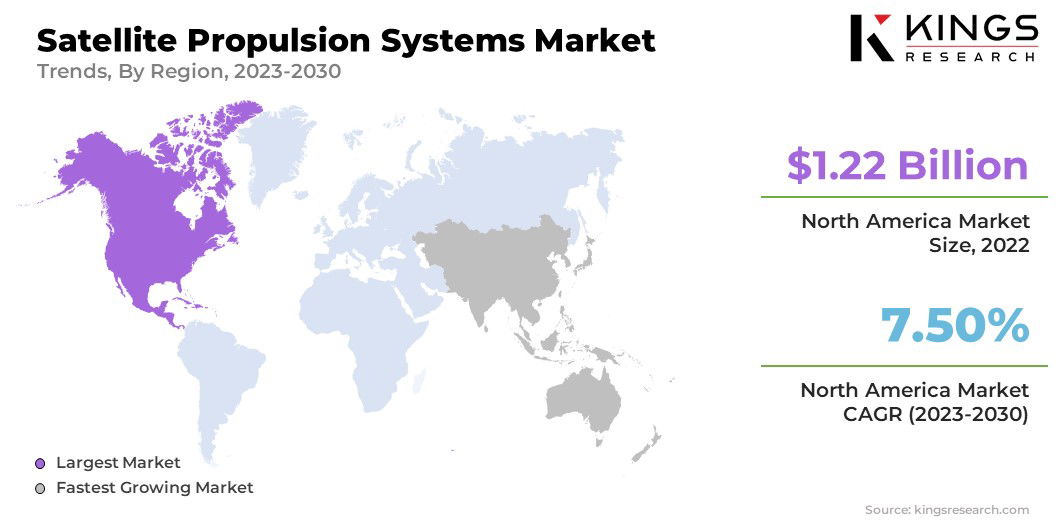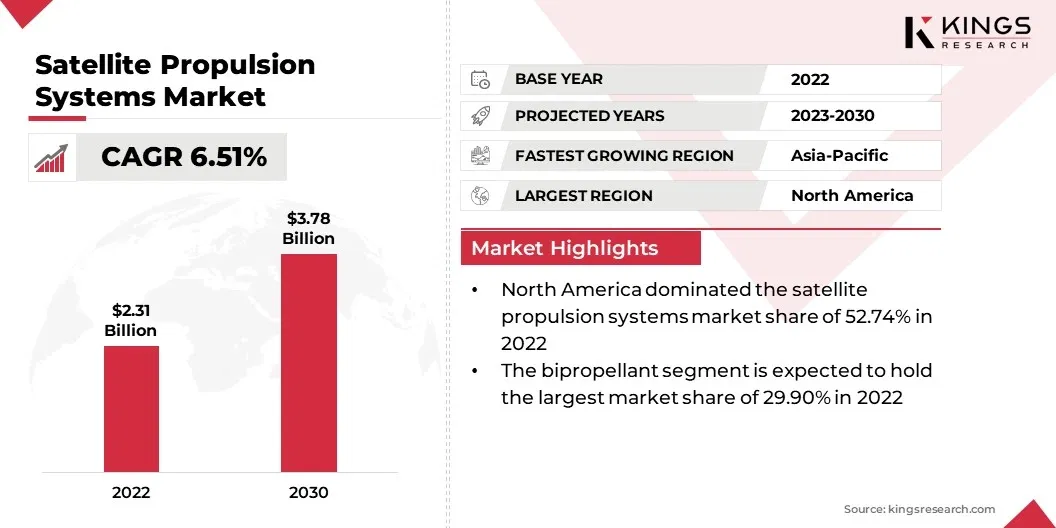Aerospace and Defense

Satellite Propulsion Systems Market

Satellite Propulsion Systems Market Size, Share, Growth & Industry Analysis, By Application (Applications Satellite, Science Satellite, Technology Experiment Satellite), By System Type (Bipropellant, Monoproprellant, Pneumatic, Others), By Propulsion Type (Cold Gas Propulsion, Pulsed Plasma Propulsion, Green Liquid, Others) and Regional Analysis, 2023-2030
Pages : 120
Base Year : 2022
Release : June 2023
Report ID: KR48
Market Perspective
The global Satellite Propulsion Systems Market was valued at USD 2.31 billion in 2022 and is projected to reach USD 3.78 billion by 2030, growing at a CAGR of 6.51% from 2023 to 2030.
Satellite propulsion systems increasingly include electric propulsion systems is driving the market growth. Electric thrusters have several advantages over traditional chemical rockets, such as requiring less propellant and providing thrust for longer periods. The development of more advanced electric thrusters is ongoing with the aim of improving their delta-v capabilities and exploring the limits of reachable space. This technology has been successfully implemented in over 500 spacecraft throughout the solar system, including for station-keeping, orbit raising, and primary propulsion, and its use is expected to continue growing in the satellite propulsion systems market. However, satellite propulsion systems face challenges such as the development of more efficient electric thrusters, which use less propellant and provide longer thrust.
Analyst’s Review on Satellite Propulsion Systems Market
The emergence of low-cost satellites has been a trend in the market since before the pandemic, and this trend is expected to continue. While some space launches were postponed in 2020, there were no significant cancellations. Additionally, governments around the world have not reduced funding for their space programs, thus supporting satellite propulsion systems market growth in the upcoming forecast period. Additionally, NASA's Jet Propulsion Laboratory has developed a high-pressure ventilator prototype in response to COVID-19, demonstrating the potential for space technology to have applications in addressing global health challenges.
Market Definition
Satellite propulsion systems can be defined as the systems used to accelerate and move spacecraft and artificial satellites in the vacuum of space. These systems can fall into several categories, including chemical propulsion, electric propulsion, and momentum wheels. Chemical propulsion involves the use of chemical rockets to create a hot gas that is expanded to produce thrust. Electric propulsion, on the other hand, uses ion thrusters or Hall-effect thrusters for propulsion, producing much higher specific impulses. The choice of propulsion system depends on the mission requirements and spacecraft design.
There are also newer technologies being developed, such as green chemical propulsion which aims to replace highly toxic fuels like hydrazine. Some satellites also use momentum wheels for attitude control. Additionally, satellite propulsion systems have a wide range of applications, from orbital station-keeping and attitude control of satellites to interplanetary missions and resupply missions to the International Space Station. Advances in propulsion technology, such as 3D printing and digital control systems, are improving the efficiency, reliability, and cost-effectiveness of satellite propulsion systems, making them an increasingly important component of space missions. With the increasing demand for satellite services and the growing interest in space exploration, the applications of satellite propulsion systems are likely to expand further in the coming years.
Market Dynamics
The commercialization of the global space industry has had a significant impact on the development and implementation of satellite propulsion systems. The demand for cost-effective and reliable satellite propulsion systems has grown due to the increase in satellite launches for commercial purposes, such as telecommunications, Earth observation, and other space-based services. Additionally, the development of new propulsion systems to meet the specific needs of commercial customers has led to innovation and new market opportunities. As the commercial space industry continues to grow, the demand for advanced satellite propulsion systems is expected to increase, driving the market's growth in the upcoming forecast period.
Satellite Propulsion Systems face several challenging factors, some of which include the development of efficient and reliable electric propulsion systems, ensuring the safety of personnel and the environment during launch and operation, and improving the durability of propulsion systems during long-duration missions. However, one of the most challenging factors in satellite propulsion is developing solutions that can withstand extreme conditions in space, which include the vacuum of space and extreme temperature variations. These conditions pose significant technical challenges in developing propulsion systems that can perform reliably and efficiently over a long period.
Segmentation Analysis
The Global Satellite Propulsion Systems Market is segmented based on System Type, Propulsion Type, Application, and Geography.
Based on the system type, the market is categorized into monopropellant, bipropellant, pneumatic/ hybrid systems, and others. The bipropellant segment is expected to hold the largest market share of 29.90% in 2022 due to the common type of chemical rocket used in satellite propulsion. These are majorly used on medium to heavy satellites and spacecraft for both space agency missions and commercial activities. There are also companies like Aerojet Rocketdyne and Northrop Grumman that specialize in the design, manufacture, integration, and testing of bipropellant systems for spacecraft. Bipropellant systems are known for their high reliability and relative simplicity, but may not be as fuel-efficient as other types of propulsion systems like electric propulsion. Overall, the developments in 3D printing and digital control systems are improving bipropellant propulsion for satellites, making them more cost-effective, reliable, and efficient solutions for space missions.
Based on the propulsion type, the market is divided into cold gas propulsion, pulsed plasma propulsion, green liquid, ambipolar thrusters, water electrolyzed, and others. The cold gas propulsion segment is expected to hold the largest market share of 34.33% in 2022. Cold gas thrusters are becoming an increasingly popular choice for satellite propulsion, particularly for small, low-cost satellites like CubeSats. These systems are simple and reliable, with low specific impulse and efficiency compared to other types of rocket engines.
However, their low cost and ease of use led to the rising popularity of other small satellites and CubeSats are driving increased development and innovation in cold gas thruster technology. In addition to CubeSats, cold gas propulsion is also used in larger satellites for environmental testing and validation, with systems like NASA's Lunar Flashlight mission using cold gas propulsion to maintain orientation and carry out science objectives. While cold gas propulsion may not be suitable for all types of space missions, its simplicity and reliability make it an attractive option for a wide range of applications.
Geographical Analysis
Based on regional analysis, the global satellite propulsion systems market is classified into North America, Europe, Asia Pacific, MEA, and Latin America.

North America dominated the satellite propulsion systems market share of 52.74% in 2022 owing to the presence of several major players in the satellite industry, including SpaceX, Northrop Grumman, Boeing, and Lockheed Martin, all are engaged in the development of advanced propulsion systems. The increasing demand for satellite services, particularly in the fields of telecommunications, earth observation, and navigation. In addition, the region's strong presence in the aerospace industry, with companies like NASA and the United Launch Alliance, is also fueling growth in the satellite propulsion market. Overall, North America is expected to continue to be a key market for satellite propulsion systems in the coming years, with a significant number of satellite launches and missions planned for the region.
Competitive Landscape
The global satellite propulsion systems industry study report will provide valuable insight with an emphasis on the global market and the market is highly fragmented. Major players are focusing on a few of the strategies such as partnerships, mergers and acquisitions, product innovations, and joint ventures to expand their product portfolio and increase their respective market shares across different regions. Expansion & investments involve investments in R&D, new Technology Experiment Satellite facilities, and supply chain optimization. The major manufacturers in the market are
- Dawn Aerospace
- Safran
- Northrop Grumman Corporation
- MT Aerospace AG
- Moog Inc.
- Rafael Advanced Defense Systems Ltd.
- IHI Corporation
- CU Aerospace
- ArianeGroup GmbH
- Exotrail
Key Developments
- November 2022 (Partnership): Sidus Space, a company that offers hardware Technology Experiment Satellite services for space missions along with commercial satellite design, manufacture, launch, and data collection, made a strategic move by being partners with Dawn Aerospace to incorporate green, chemical propulsion technology into their satellite called LizzieSat.
- August 2022: IHI Aerospace Co., Ltd (IA), a wholly-owned subsidiary of IHI Corporation, will be supplying OHB Sweden with 1N thrusters to facilitate maneuverability for a commercial satellite
- July 2022 (Launch)- Moog has released a new spacecraft mechanism in anticipation of the Small Satellite Conference (SmallSat) in Logan, Utah to cater to the demands of the rapidly expanding small satellite market.
The global satellite propulsion systems market is segmented as:
By System Type
- Monoproprellant
- Bipropellant
- Pneumatic/ Hybrid Systems
- Others
By Propulsion Type
- Cold Gas Propulsion
- Pulsed Plasma Propulsion
- Green Liquid
- Ambipolar Thrusters
- Water Electrolysed
- Others
By Application
- Applications Satellite
- Science Satellite
- Technology Experiment Satellite
By Region
- North America
- U.S.
- Canada
- Mexico
- Europe
- France
- UK
- Spain
- Germany
- Italy
- Russia
- Rest of Europe
- Asia Pacific
- China
- Japan
- India
- South Korea
- Rest of Asia Pacific
- Middle East & Africa
- GCC
- North Africa
- South Africa
- Rest of the Middle East & Africa
- Latin America
- Brazil
- Argentina
- Rest of Latin America
CHOOSE LICENCE TYPE
Frequently Asked Questions (FAQ's)
Get the latest!
Get actionable strategies to empower your business and market domination
- Deliver Revenue Impact
- Demand Supply Patterns
- Market Estimation
- Real-Time Insights
- Market Intelligence
- Lucrative Growth Opportunities
- Micro & Macro Economic Factors
- Futuristic Market Solutions
- Revenue-Driven Results
- Innovative Thought Leadership

.webp)